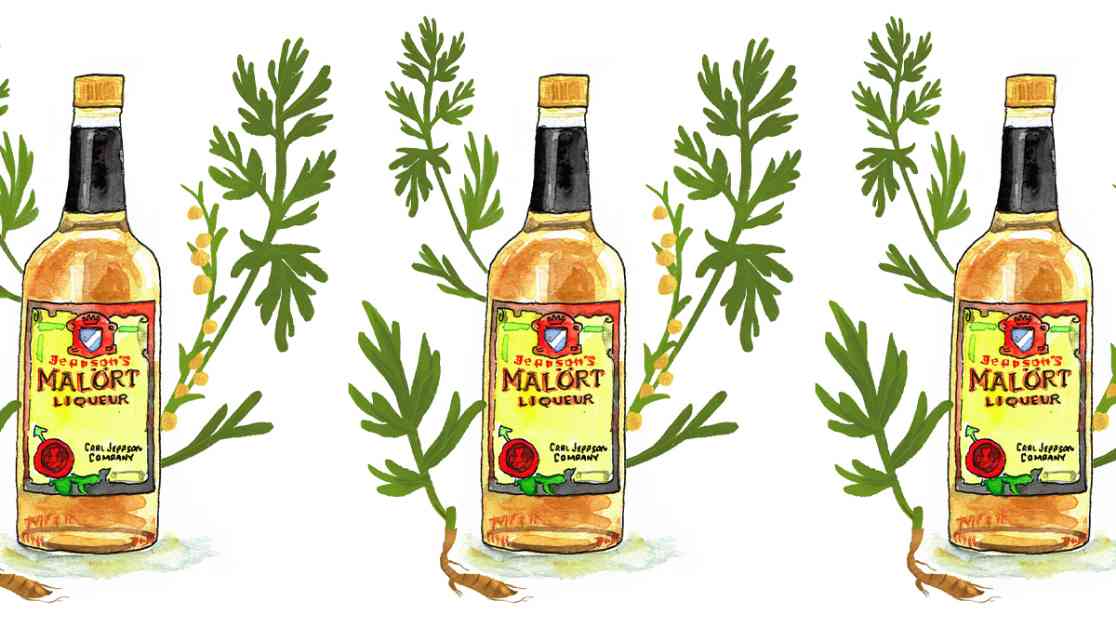There’s a shot glass filled with Jeppson’s Malört in front of me. I’ve never had Malört. The bottles of amber sadness are inescapable in Chicago—bars, parties, concert venues—and I had heard all the jokes, but never partaken. I am scared.
“I’m going to predict that you will find it less bad than you are expecting,” says Josh Noel.
Noel is an author, libation philosopher, and former beer and travel writer for the Chicago Tribune. His new book, Malört: The Redemption of a Revered and Reviled Spirit (Chicago Review Press), is about the history and legacy of Malört—it’s an immigrant story, a business story, and even a love story.
Jeppson’s Malört, purchased by CH Distillery in 2018, has lived many different lives. Noel’s book follows every thread, from Malört’s beginnings as a European oddity purchased by Chicago businessman George Brode on a lark from Swedish immigrant Carl Jeppson, to its modern teeter on the mainstream edge. When Brode died in 1999, his longtime secretary and partner Patricia Gabelick became the brand’s caretaker and almost single-handedly saved it from the sink drain of history.
Malört’s broad story is fairly well-documented elsewhere, but Noel uses his book to fill in the unseen details, emphasizing the people like Gabelick who propelled the drink forward.
“I was trying to sort of demystify Malört a little bit,” Noel says. “It’s got this fascination and mystery about it and reverence, but it wasn’t very well understood as anything more than this sort of weird joke shot in Chicago bars.”
Chicagoans mythologize Malört—recommend pairings and taste work-arounds, share horror stories and late-night CTA odysseys. Noel’s advice? Stop thinking and let your senses tell the story.
We’re at Christina’s Place, a 4 AM bar on Kedzie in Irving Park across the street from the post office. It’s Monday. The last few deep orange rays of the setting sun shine through the windows and onto bottles of everything, Malört included. Last year, a 21-year-old man was shot and killed by police after allegedly pulling a gun on a security guard outside the bar. Tonight, everyone in the bar is cheering on the Cubs, who aren’t doing half bad. Malört is at home behind the counter of places like these, as set dressing to their stories, good and bad.
“Let’s drink,” Noel says. He is the navigator.
The smell has heft; it’s bitter and somewhat fruity. There’s happy chatter and the odd clack of pool balls around us.
“The payoff comes in the aftertaste,” Noel says, still wincing a little. “In the walk-off, I always think ‘rubber bands.’ Not that I’ve eaten a lot of rubber bands.”
It’s funny to think that, despite having never tried Malört until that night, I was fully aware of the lore surrounding it. Even as far out as Kane County where I grew up, Malört was name-dropped. CH Distillery has leaned into Jeppson’s identity with a new fleet of trucks adorned with photos of wincing people. It’s a testament to the fact that Malört has an unmatched reputation compared to other regional shots.
Noel witnessed the Malört-aissance firsthand while covering food and drink for the Tribune, most notably in the early 2010s, when the drink was propelled back into the Chicago consciousness. In his book, Noel partly credits Malört to a mix of trendsetting bartenders and savvy early coverage from food and drink writers. Part of the book is dedicated to the Reader’s own role in popularizing Malört.
Stop thinking and let your senses tell the story.
“I knew people were really, really interested in it,” says Noel, “and the way I knew was anytime I wrote about Malört in the Tribune, those stories got read.”
In writing Malört, Noel aims to set the jokes and stories aside and try to definitively understand the drink and the people behind it. He says some of the history was hazy even for Malört’s current producers.
“I interviewed the owner of CH [Distillery], talked to him seven, eight times over the course of the recording[s]. He said more than once, ‘Man, I can’t wait to read the book, there’s so much of this brand I don’t know.’”
This also isn’t Noel’s first rodeo tackling a Chicago libation. His previous book, Barrel-Aged Stout and Selling Out (Chicago Review Press, 2018), profiled Goose Island and its rise and eventual sale to Anheuser-Busch. Like Jeppson’s, Noel says Goose Island’s meteoric rise to a household name was propelled by an eclectic mix of savvy innovators caught in the middle of an industry in need of change.
“The front story was Goose Island, but really that story is about the rise of craft beer—the ways and reasons the big beer companies felt like they had to get involved with craft beer.”
Noel will spend most of September bringing the Malört story on the road, with readings and book events scheduled in Chicago and as far out as New York City. He’ll wrap up his tour back in Chicago on Sunday, September 29, with a 4 PM Q&A hosted by Block Club Chicago at the Green Mill, a bar that has fittingly sold more Malört than any other bar, according to Noel’s website. The event will end with one final Malört toast.
“I don’t really know what to expect. In Chicago there will be a lot of interest and excitement,” Noel says. “CH Distillery, they’re the [Malört] ambassadors. I’m here to tell the story.”
During a pause in conversation at Christina’s, Noel asks the bartender if Malört is still popular. She nods and says that they always need to order more.
As far as the next chapter of Malört’s story is concerned, Noel says, “The growth [Malört] has experienced in the last 15 years is just amazing. [Any] Chicago bar worth stepping into, I presume at this point, has a bottle behind the bar.”


